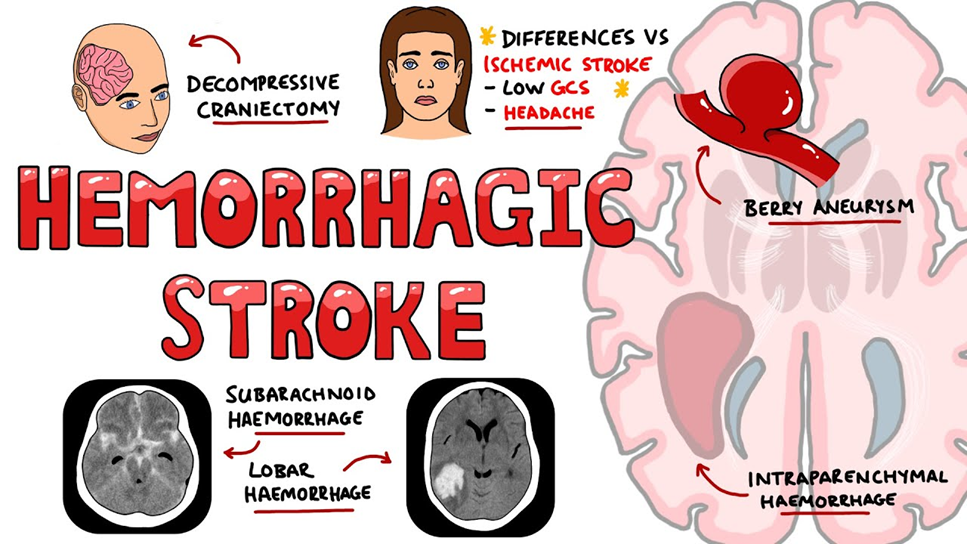The nurse is caring for a client who had a hemorrhagic stroke. Which assessment finding is the earliest sign of increasing intracranial pressure (ICP) for this client?
Severe hypertension
Dilated and nonreactive pupils
Decreased level of consciousness
Projectile vomiting
None
None
The Correct Answer is C
Choice A: Severe Hypertension
Severe hypertension can be a sign of increased intracranial pressure (ICP), but it is not typically the earliest sign. Hypertension often occurs as a compensatory mechanism to maintain cerebral perfusion pressure. While it is a significant finding, it usually follows other more immediate signs of increased ICP.
Choice B: Dilated and Nonreactive Pupils
Dilated and nonreactive pupils are a late sign of increased ICP and indicate severe brainstem compression. This finding suggests that the pressure has reached a critical level, leading to brain herniation. It is a very serious sign but not the earliest indicator of increasing ICP.
Choice C: Decreased Level of Consciousness
A decreased level of consciousness is often the earliest and most sensitive indicator of increasing ICP. Changes in consciousness can range from confusion and lethargy to complete unresponsiveness. This symptom reflects the brain’s response to increased pressure and reduced cerebral perfusion, making it a critical early sign that requires immediate attention.

Choice D: Projectile Vomiting
Projectile vomiting can occur with increased ICP due to pressure on the vomiting centers in the brainstem. However, it is not typically the earliest sign. Vomiting often accompanies other symptoms such as headache and changes in consciousness.
Nursing Test Bank
Naxlex Comprehensive Predictor Exams
Related Questions
Correct Answer is ["A","D","E"]
Explanation
Choice A Reason:
Cool, clammy skin is a common symptom in patients with atrial fibrillation, especially when the heart rate is very high. This symptom occurs due to decreased cardiac output, which leads to poor perfusion of the skin. When the heart is beating too fast, it doesn’t have enough time to fill properly, resulting in less blood being pumped out to the body. This can cause the skin to feel cool and clammy as the body tries to compensate for the reduced blood flow.
Choice B Reason:
Respiratory rate of 20 is within the normal range for adults, which is typically 12-20 breaths per minute. While it is important to monitor respiratory rate in patients with atrial fibrillation, a rate of 20 does not indicate any immediate distress or abnormality. Therefore, this choice is not particularly relevant to the assessment of a patient with a heart rate of 143 beats/min due to atrial fibrillation.
Choice C Reason:
Flushing of the skin is not a typical symptom associated with atrial fibrillation. Flushing can occur due to various reasons such as fever, anxiety, or certain medications, but it is not directly linked to the high heart rate or the irregular rhythm seen in atrial fibrillation. Therefore, this choice is not applicable in this context.
Choice D Reason:
Hypotension (low blood pressure) is a significant concern in patients with atrial fibrillation, especially when the heart rate is very high. The rapid heart rate can lead to decreased cardiac output, as the heart does not have enough time to fill properly between beats. This can result in lower blood pressure, which can cause symptoms such as dizziness, fainting, and fatigue. Monitoring blood pressure is crucial in managing patients with atrial fibrillation to prevent complications.
Choice E Reason:
Chest discomfort is a common symptom in patients with atrial fibrillation, particularly when the heart rate is very high. The irregular and rapid heart rate can cause the heart to work harder, leading to increased oxygen demand and potentially reduced oxygen supply to the heart muscle. This imbalance can result in chest pain or discomfort, which is a warning sign that the heart is under stress. It is important to assess and address chest discomfort promptly to prevent further cardiac complications.
Correct Answer is B
Explanation
Choice A Reason:
Documenting that the nasogastric tube is in the correct place is not appropriate in this scenario. The normal pH range for gastric contents is typically between 1.5 and 3.5. A pH of 7.35 is much higher than this range, indicating that the tube may not be in the stomach. Therefore, documenting the tube as correctly placed could lead to potential complications, such as improper feeding or medication administration.
Choice B Reason:
Notifying the health care provider is the correct action. A pH of 7.35 suggests that the nasogastric tube may be misplaced, possibly in the respiratory tract or another non-gastric location. Immediate notification of the health care provider is crucial to prevent any adverse outcomes and to take corrective measures, such as confirming placement with an X-ray or re-inserting the tube.
Choice C Reason:
Checking for placement by auscultating for air injected into the tube is not a reliable method for verifying nasogastric tube placement. While this method was traditionally used, it has been found to be inaccurate and is no longer recommended. The sound of air entering the stomach can be misleading and does not confirm correct placement.
Choice D Reason:
Retesting the pH using another strip is not the best immediate action. While it is important to ensure the accuracy of the pH reading, a pH of 7.35 is significantly outside the normal gastric range, and retesting is unlikely to yield a different result. The priority should be to notify the health care provider to address the potential misplacement of the tube.
Whether you are a student looking to ace your exams or a practicing nurse seeking to enhance your expertise , our nursing education contents will empower you with the confidence and competence to make a difference in the lives of patients and become a respected leader in the healthcare field.
Visit Naxlex, invest in your future and unlock endless possibilities with our unparalleled nursing education contents today
Report Wrong Answer on the Current Question
Do you disagree with the answer? If yes, what is your expected answer? Explain.
Kindly be descriptive with the issue you are facing.
